长江中下游成矿带是我国华南地区重要的多金属成矿带,以广泛分布的中生代岩浆热液型铜金钼铁矿床而闻名(Xie et al., 2011; Mao et al., 2013)。近年来,在该成矿带南侧相继发现了朱溪、大湖塘等大型-超大型钨矿床(陈国华等, 2012; 项新葵等, 2012),加上已往发现的北东向分布的一系列钨多金属矿床,共同构成了一条在南岭之外的新的重要钨矿带(Zhao et al., 2017, 2021)。前人对于南岭成矿带已经有了较深入的研究,取得了包括“五层楼+地下室”勘查模型和“九龙脑模式”等一系列理论成果(王登红等, 2010; 赵正等, 2017a, b; Zhao et al., 2018b; 尹政等, 2021)。而对于长江中下游钨矿床的研究主要集中于朱溪、大湖塘、阳储岭等中大型矿床(刘善宝等, 2017; 李宏伟等, 2021),显示主要成矿时间为早燕山期150~135Ma(Zhao et al., 2017, 2021)。
香炉山钨矿是长江中下游南侧钨(铜钼)矿带中一个大型矽卡岩型钨矿床,赋存达29.6万吨的WO3(田邦生和袁步云, 2008; 张家菁等, 2008; 吴胜华等, 2014)。前人针对该矿床的地质特征、成矿年代学、矿物学和流体包裹体等方面进行了探讨(陈耿炎, 1990; 田邦生和袁步云, 2008; 张家菁等, 2008; 刘勇和周贤旭, 2010; 陈波和周贤旭, 2012; 吴胜华等, 2014; Dai et al., 2018; Wu et al., 2019; Li et al., 2020; 吴胜华等, 2020)。这些成果为该矿床的进一步研究及区域成矿规律奠定了一定基础。研究结果显示,香炉山钨矿形成时代为晚燕山期(~127Ma)(陈耿炎, 1990; 张家菁等, 2008; Zhao et al., 2017; Dai et al., 2018; Li et al., 2020),远远年轻于该区域其他典型钨矿床。然而,对其矽卡岩特征与成矿过程仍缺乏详细探讨。Wu et al. (2019)、Li et al. (2020)和吴胜华等(2020)通过对香炉山矿床中的白钨矿、锆石和硫化物微量元素和同位素的研究,显示出其相较于该带早燕山期大湖塘钨矿和南岭的早燕山期柿竹园钨矿,具有相对单一的硫化物组成和花岗岩低氧逸度的特征,指示其具有相对独特的成矿过程和背景。因此,对该矿床特征及花岗岩地球化学特征更进一步的刻画和限定,将有助于长江中下游成矿带的总体认识。
矽卡岩钨矿床作为最重要的钨矿床类型之一,通常分为氧化型矽卡岩钨矿床和还原型矽卡岩钨矿床(Newberry and Einaudi, 1981; Newberry and Layer, 1998)。一般来讲,还原型矽卡岩钨矿床相较于氧化型矽卡岩钨矿床规模更大(Meinert et al., 2005)。因此,限定矽卡岩型钨矿的类型,将有助于对该矿床的成矿机理研究和资源潜力评估。氧化型和还原型矽卡岩钨矿床分别在矽卡岩矿物组合和成分,以及成矿花岗岩特征上均具有显著的差别(Newberry and Layer, 1998; Meinert et al., 2005)。本文将通过研究香炉山钨矿床中矽卡岩矿物和成矿花岗岩的成分特征,限定香炉山钨矿的矽卡岩氧化-还原类型,结合前人研究成果,为成矿流体及物质来源和花岗岩地球化学特征提供指示,同时为区域成矿规律和成矿预测提供依据。
1 区域地质背景香炉山钨矿位于华南扬子板块北部长江中下游成矿带的西南端,北邻秦岭-大别造山带和华北板块(图 1)。该成矿带以斑岩-矽卡岩矿床为主,包含北侧的铜金钼铁矿带(Xie et al., 2011; Mao et al., 2013),和南侧的钨(铜钼)矿带(Mao et al., 2013; Zhao et al., 2017, 2021)。该地区基底为一套中元古界双桥山群浅变质岩,上覆新元古界-志留系碎屑岩、中泥盆统-下三叠统碳酸盐岩、中三叠统-下侏罗统陆源碎屑岩和早白垩世火山岩(Mao et al., 2013)。该地区主要出露新元古代九岭花岗岩和众多中生代花岗岩。九岭花岗岩呈巨大岩基展布,其岩性主要为黑云母花岗闪长岩、黑云母花岗岩和二云母花岗岩,其年龄为~830Ma(钟玉芳等, 2005)。中生代花岗岩侵位于九岭花岗岩及区域地层中,其岩性主要为黑云母花岗岩、花岗闪长岩和花岗斑岩,其年龄为158~118Ma(袁媛等, 2012)。中生代花岗岩与区域钨多金属成矿作用密切相关(Mao et al., 2013; Zhao et al., 2017, 2021)。区域的基底构造以南北向的褶皱系和近东西向构造系为主(章泽军等, 2003),盖层构造以北东东向和北北东向褶皱和断裂构造系为主(黄修保, 2001)。中生代花岗岩和矿体主要分布于北北东向和北东东向断裂的复合部位(丰成友等, 2012)。
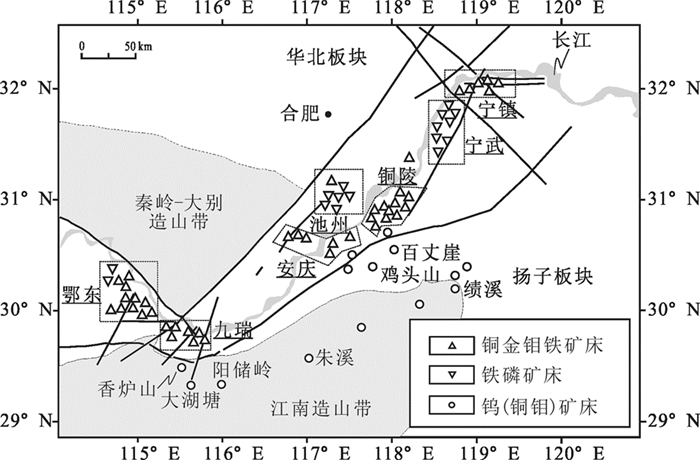
|
图 1 长江中下游成矿带矿床分布简图(据Zhao et al., 2017修改) Fig. 1 Simplified map showing major mineral deposits in the Middle-Lower Yangtze River Metallogenic Belt (modified after Zhao et al., 2017) |
香炉山矿区地处九江坳陷与九岭隆起的交界地带,位于香炉山-观音堂背斜西南倾伏端(图 2)。矿区出露地层主要为中寒武统杨柳岗组含炭质灰岩和上寒武统华严寺组深灰色条带状泥质灰岩。香炉山地区的花岗岩出露于矿区东北部,进一步由西向东分为任家山岩体、高湖岩体和太阳山岩体,但三者在深部为一整体并无明显区分(吴胜华等, 2014)。

|
图 2 香炉山矽卡岩型钨矿床地质简图(据田邦生和袁步云, 2008修改) 1-上寒武统华严寺组条带状灰岩;2-中寒武统杨柳岗组含炭质灰岩;3-下寒武统王音铺、观音堂组炭质页岩;4-奥陶系泥岩、页岩;5-志留系砂岩;6-香炉山花岗岩;7-细晶岩;8-矽卡岩钨矿体;9-角砾岩;10-香炉山背斜;11-走滑断层;12-逆冲断层 Fig. 2 Simplified geological map of the Xianglushan deposit (modified after Tian and Yuan, 2008) 1-banded limestone of the Upper Cambrian Huayanshi Fm.; 2-Carbonaceous siliceous-argillaceous limestone of the Middle Cambrian Yangliugang Fm.; 3-Carbonaceous shale of the Lower Cambrian Wangyinpu and Guanyintang Fm.; 4-Ordovician mudstone and shale; 5-Silurian sandstone; 6-Xianglushan granite; 7-aplite; 8-skarn orebody; 9-breccia; 10-Xianglushan anticline; 11-strike-slip faults; 12-thrust faults |
香炉山花岗岩呈细粒到中粗粒结构,主要由石英(55%~60%)、钾长石(~20%)、斜长石(10%~15%)和黑云母(5%~10%)组成,副矿物以钛铁矿为主,为黑云母花岗岩(Dai et al., 2018)。香炉山白钨矿体主要赋存于杨柳岗组与香炉山花岗岩接触带部位,矿化带长度>4km,宽1.5km(田邦生和袁步云, 2008)。矽卡岩矿体呈似层状(图 3a)与地层产状近乎平行,倾角较缓。矿体整体呈北东向展布,向接触带两侧尖灭,以背斜核部为界,分别北西和南东向倾斜。由接触中心向外矽卡岩化逐渐减弱。在外接触带中岩石常呈现细粒变晶结构或条纹条带状构造,并主要形成了辉石、黑云母、长石、石榴石、红柱石、符山石、绿帘石、阳起石、透闪石等矽卡岩矿物;而在内接触带中,热液变质作用主要表现为云英岩化、硅化、绿泥石化、萤石化和高岭土化等(田邦生和袁步云, 2008)。其中矽卡岩化和云英岩化是钨矿成矿阶段主要蚀变,而硅化、绿泥石化、萤石化等蚀变则是后期石英-硫化物阶段的典型产物(田邦生和袁步云, 2008)。在接触带外侧还发育一些扁豆状和透镜状矿体(吴胜华等, 2014)。
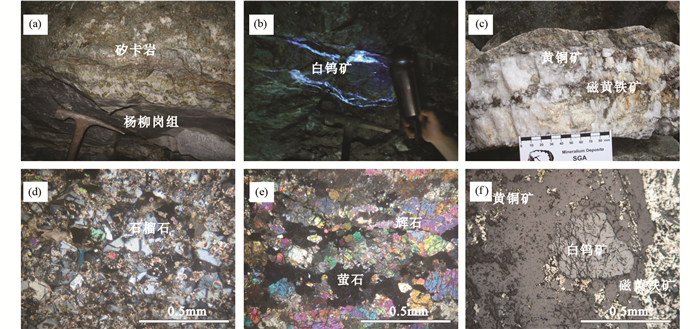
|
图 3 香炉山矽卡岩野外及镜下照片 (a)矽卡岩呈似层状产出;(b)白钨矿呈网脉状穿插于早期矽卡岩;(c)石英硫化物脉;(d)石榴石矽卡岩;(e)辉石矽卡岩;(f)白钨矿与黄铜矿和磁黄铁矿在石英脉中共生 Fig. 3 Field and microscopic images of the Xianglushan deposit (a) stratiform skarn; (b) scheelite veins crosscutting the early skarn assemblage; (c) quartz-sulfide vein; (d) garnet skarn; (e) pyroxene skarn; (f) scheelite intergrowth with chalcopyrite and pyrrhotite in quartz vein |
矽卡岩型矿石呈浸染状-细脉状构造(图 3b),矽卡岩矿物主要为石榴石和辉石,矿石矿物主要为白钨矿和黄铜矿(图 3c)。石榴石和辉石呈嵌晶结构。石榴石矽卡岩中,石榴石呈一级灰干涉色并见双晶(图 3d),主要为钙铝榴石。辉石矽卡岩中,辉石呈半自形到他形粒状,空隙充填萤石(图 3e)。白钨矿呈半自形或他形粒状为主,石榴石和石英矿物缝隙,部分与黄铜矿和磁黄铁矿共生(图 3f)。整个成矿过程可分为两个成矿期,包括矽卡岩期和石英硫化物期。矽卡岩期可分成三个成矿阶段,主要形成各种钙、铁、镁、铝的硅酸盐矿物。在早期矽卡岩阶段主要生成以岛状和链状的无水硅酸盐。似层状白钨矿主要在这一阶段中的钙矽卡岩中产出。晚期矽卡岩阶段主要特征为形成的角闪石、绿帘石、阳起石、透闪石等含水硅酸盐矿物交代早期矽卡岩矿物。最后的氧化物阶段介于矽卡岩期与石英硫化物期之间,具有过渡性质。在这一阶段可形成长石类以及云母类矿物。在这一阶段生成的白钨矿呈网脉状穿插在早期矽卡岩矿物中。在石英硫化物期中二氧化硅独立的形成大量的石英,并伴有大量金属硫化物的形成,可划分为两个成矿阶段。在早期硫化物阶段中主要生成黄铜矿、黄铁矿、毒砂等铁铜硫化物。而晚期硫化物阶段中主要形成碳酸盐矿物与方铅矿、闪锌矿等铅锌硫化物。
3 样品和测试方法本次测试样品均为新鲜岩石,采自香炉山钨矿矿区。其中香炉山花岗岩样品6件,制作成粉末后,用于全岩主微量元素分析。矽卡岩样品14件,制作成光片后,分别在光学显微镜和电子显微镜下进行观察和矿物鉴别,随后选择进行原位主微量分析和原位硫同位素分析。
3.1 全岩主微量分析香炉山花岗岩全岩主微量元素分析在广州澳实分析检测中心完成。全岩主量元素分析仪器使用PANalytical PW2424 X射线荧光光谱仪。主量各元素分析谱线均为Kα,数据校正采用理论α系数法,测试相对标准偏差(RSD) < 5%。全岩微量元素分析仪器使用Agilent 7900电感耦合等离子体质谱。样品测试前加入硼酸锂(LiBO2/Li2B4O7)熔剂,混合均匀,在熔炉中于1025℃熔融。待熔融液冷却后,用硝酸、盐酸和氢氟酸消解并定容。
3.2 矿物原位主微量分析石榴石、辉石和白钨矿原位主量元素分析在香港大学地球科学系完成,仪器型号为日本电子JXA8230,测试加速电压为15kV,电流20nA,束斑大小为1μm。白钨矿原位微量元素分析在南京聚谱检测科技有限公司完成,仪器型号为Agilent 7700X ICP-MS连接Photon Machines Excite 193nm激光剥蚀系统。激光剥蚀束斑大小为25μm。NIST 610作为外标,GSE-1G、BHVO-2G、BCR-2G和NIST 612作为监控标样。Ca作为白钨矿分析内标元素,数据处理时用相应点位的电子探针数据作校正。
3.3 矿物原位硫同位素分析硫化物原位硫同位素分析在芬兰地质调查局完成,仪器型号为Nu Plasma HR MC-ICP-MS连接Photon Machine Analyte G2激光剥蚀系统。激光分析束斑直径为50μm,频率为5Hz。氦气作为载气运送剥蚀物质(Müller et al., 2009)。空白背景信号采集时间为20s,样品剥蚀成分信号采集时间为60s。校正标样为黄铁矿国际标样PPP-1(Gilbert et al., 2014),同时内部标样Py2作为监控标样。具体实验步骤和分析流程参见Wong et al. (2017)。
4 测试结果 4.1 岩石全岩主微量成分香炉山花岗岩主微量成分分析结果见表 1。岩石主量元素表现出集中的变化:SiO2含量为66.37%~67.76%,Al2O3含量为12.30%~12.82%,TiO2含量为0.19%~0.24%,Fe2O3T含量为1.45%~1.88%,MnO含量为0.08%~0.09%,MgO含量为0.35%~0.47%,CaO含量为0.82%~0.96%,Na2O含量为2.78%~3.18%,K2O含量为5.36%~5.69%,以及P2O5含量为0.08%~0.11%。
|
|
表 1 香炉山花岗岩主量元素(wt%)和微量元素(×10-6)成分 Table 1 Major element (wt%) and trace element (×10-6) compositions of the Xianglushan granite |
香炉山花岗岩稀土元素总含量(∑REE)为187×10-6~237×10-6,其中轻稀土(LREE)为133×10-6~175×10-6,重稀土(HREE)为54.2×10-6~68.0×10-6,轻重稀土比值(LREE/HREE)为2.2~2.8,和(La/Yb)N=5.4~7.4。稀土元素总体表现为轻稀土富集。球粒陨石标准化稀土元素配分图呈现右倾形式(图 4b),δEu为0.17~0.20,具有强负异常;δCe为0.94~1.04,异常不明显。香炉山花岗岩E-MORB标准化微量元素蛛网图为右倾形式(图 4a),呈现出Rb、U等大离子亲石元素相对富集,Nb、Zr等高场强元素相对亏损。
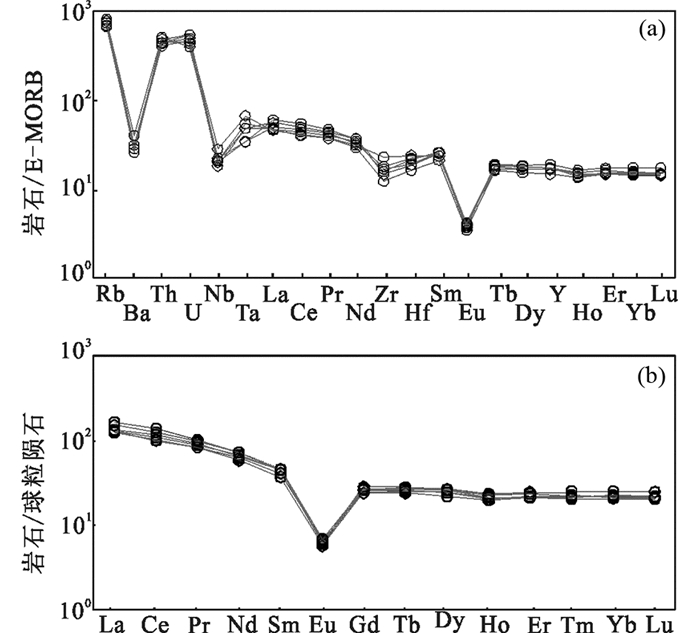
|
图 4 香炉山花岗岩E-MORB标准化微量元素蛛网图(a)和球粒陨石标准化稀土元素配分图(b)(标准化值据Sun and McDonough, 1989) Fig. 4 E-MORB-normalized trace elements patterns (a) and chondrite-normalized REE patterns (b) of the Xianglushan granite (normalization values after Sun and McDonough, 1989) |
石榴石、辉石和白钨矿原位主量成分分析结果见表 2。石榴石的SiO2、Al2O3和FeO较高且变化不大,分别为37.25%~38.64%、18.06%~19.98%和6.72%~9.39%,而CaO和MnO含量变化较大,分别为21.35%~34.02%和1.30%~11.27%。TiO2和MgO的含量较低,部分低于电子探针检测限,最高值分别为0.75%和0.06%。石榴石端元组分成分跨度较大,其中钙铝榴石为54%~81%,钙铁榴石为5%~14%,以及锰铝-铁铝榴石为5%~40%(图 5a),其中矽卡岩晚期石榴石往往呈现富锰铝-铁铝榴石组分的特征,接近于锰质矽卡岩。
|
|
表 2 香炉山矽卡岩矿床石榴石、辉石和白钨矿电子探针分析结果(wt%) Table 2 EMPA results of garnet, pyroxene and scheelite from the Xianglushan deposit (wt%) |
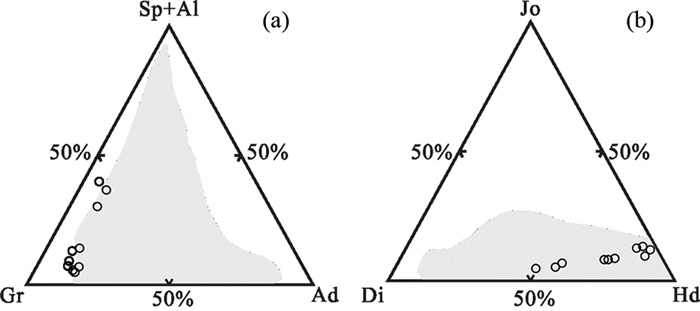
|
图 5 香炉山矽卡岩石榴石端元成分(a)和辉石端元成分(b)三角投图(底图据Meinert et al., 2005) Fig. 5 End member component plots of garnet (a) and pyroxene (b) from Xianglushan skarns (reference domains from Meinert et al., 2005) Abbreviations: Sp-spessartine; Al-almandine; Gr-grossular; Ad-andradite; Jo-johannsenite; Di-diopside; Hd-hedenbergite |
辉石的SiO2和CaO含量较高且变化较小,分别为49.22%~52.21%和22.15%~22.91%,而FeO和MgO含量变化较大,分别为15.73%~26.06%和0.50%~8.18%。MnO和Al2O3的含量较低,分别为1.35%~3.95%和0.12%~0.53%。TiO2的含量可低于电子探针检测限,最高仅可达0.05%。辉石端元成分主要为钙铁辉石(50%~86%),其次为透辉石(3%~46%)和锰钙辉石(4%~13%)(图 5b),其中早期矽卡岩辉石相对于晚期矽卡岩辉石有相对富透辉石组分的趋势,并且单颗粒辉石中有时呈现核部富透辉石组分和边部富钙铁辉石组分的特征。
白钨矿的WO3和CaO含量较高且变化不大,分别为79.83%~81.16%和18.55%~19.90%。SiO2和FeO的含量较低,分别为0.10%~0.29%和0.02%~0.04%。MgO、MnO和Al2O3的含量部分低于电子探针检测限,最高值分别为0.04%、0.02%和0.12%,可能受显微矿物包裹体的影响。
白钨矿原位微量元素成分分析结果见表 3。白钨矿的Mo含量较低,为31.2×10-6~453×10-6,同时含有一定量的Ga(0.07×10-6~1.73×10-6)、Sr(13.4×10-6~46.5×10-6)、Nb(12.3×10-6~90.5×10-6)、Ta(0.11×10-6~2.74×10-6)和Pb(1.01×10-6~7.62×10-6)。Na、Cu、Zn、Rb、Sn、Th和U部分低于ICP-MS检测限,但最高值分别可达61.1×10-6、0.61×10-6、2.87×10-6、1.87×10-6、0.80×10-6、29.5×10-6和59.7×10-6。白钨矿稀土元素的含量较高且变化范围大,为66×10-6~1001×10-6,其在球粒陨石标准化图中呈现右倾的特征,且具有显著的Eu正异常(图 6a)。根据Zhao et al. (2018a)获得的矽卡岩白钨矿晶格应变模型(Lattice Strain Model)参数(r0=1.072Å, EM=4565kbar),以及吴胜华等(2014)通过流体包裹体获得的温度(T=500K),通过晶格应变模型变形方程:log(xiD0/Di)=logxi+[(4πNAloge)/R]×(EM/T)×[r0(ri-r0)2/2+(ri-r0)3/3],获得白钨矿沉淀时成矿热液流体中稀土元素配分形式(图 6b)。如图 6b所示,呈现出右倾且重稀土相对于轻稀土升高的特征。
|
|
表 3 香炉山矽卡岩矿床白钨矿LA-ICP-MS分析结果(×10-6) Table 3 LA-ICP-MS results of scheelite from the Xianglushan deposit (×10-6) |
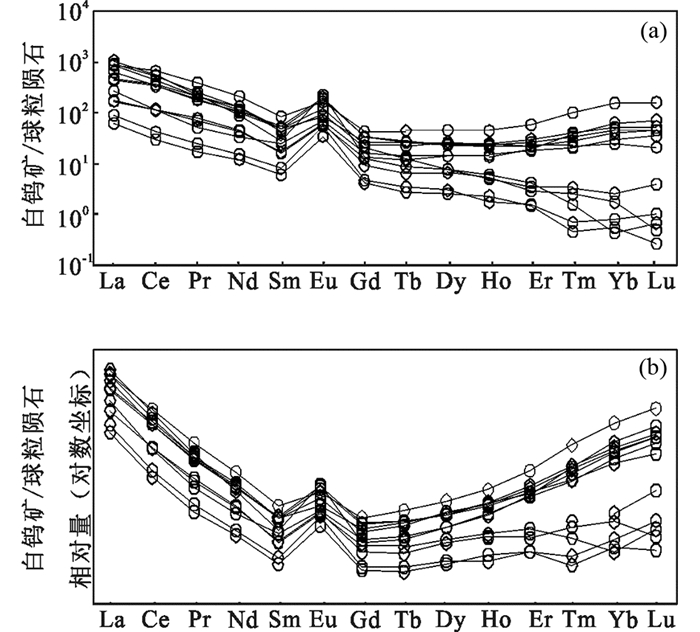
|
图 6 香炉山矽卡岩白钨矿球粒陨石标准化稀土元素配分图(a)和晶格应变模型恢复的流体球粒陨石标准化配分形式(b)(标准化值据Sun and McDonough, 1989) Fig. 6 Chondrite-normalized REE patterns of the scheelite (a) and the LSM-modeled chondrite-normalized REE patterns of the hydrothermal fluids (b) (normalization values after Sun and McDonough, 1989) |
黄铜矿和磁黄铁矿原位硫同位素成分分析结果见表 4。黄铜矿的δ34SCDT值为1.0‰~4.2‰,磁黄铁矿的δ34SCDT值为3.0‰~5.2‰。可见磁黄铁矿相较于黄铜矿富集重硫同位素。
|
|
表 4 香炉山矽卡岩矿床黄铜矿和磁黄铁矿原位硫同位素分析结果 Table 4 In-situ S isotopic compositions of chalcopyrite and pyrrhotite from Xianglushan |
矽卡岩型钨矿的成矿岩体通常具有过铝质的特征(Meinert et al., 2005)。香炉山花岗岩成分在TAS图解(图 7a)中,投点于高K2O+Na2O和高SiO2花岗岩类范围,具有亚碱性的特征。同时,花岗岩成分在K2O-SiO2图解(图 7b)中,投点于钾玄岩系列范围。香炉山花岗岩铝饱和指数为1.31~1.35,属于强过铝质(图 7c)。香炉山花岗岩成分特征与全球典型矽卡岩型钨矿成矿花岗岩特征接近(Meinert et al., 2005)。在Zr+Nb+Ce+Y-(K2O+Na2O)/CaO图解(图 7d)中,香炉山花岗岩成分落入分异的S型和分异的I型重合区域。此外,香炉山花岗岩成分在A/NK-A/CNK图解中,投点也位于S型花岗岩一侧。在La/Sm-La图解(图 8a)中,香炉山花岗岩成分显示岩石形成过程和分离结晶过程密切相关。因此,香炉山花岗岩属于分异的S型花岗岩(Sylvester, 1998),这也与华南其他与钨成矿相关花岗岩的成分特征相一致(图 7; Zhao et al., 2021)。
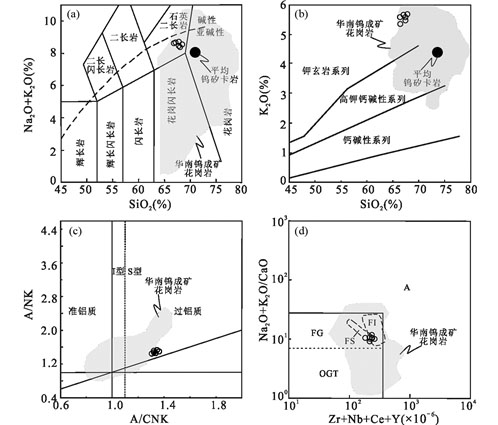
|
图 7 香炉山花岗岩地球化学图解 (a)TAS分类图解(Middlemost, 1994);(b)K2O-SiO2图解(Middlemost, 1994);(c)A/NK-A/CNK图解(Maniar and Piccoli, 1989);(d)花岗岩类型判别图解(Whalen et al., 1987).平均矽卡岩钨成矿相关花岗岩数据自Meinert et al. (2005),华南钨成矿花岗岩数据自Zhao et al. (2021)及其参考文献 Fig. 7 Geochemical diagrams of the Xianglushan granite (a) TAS diagram (Middlemost, 1994); (b) K2O vs. SiO2 diagram (Middlemost, 1994); (c) A/NK vs. A/CNK diagram (Maniar and Piccoli, 1989); (d) granite discrimination diagram (Whalen et al., 1987). Geochemical data of average W-skarn related granites from Meinert et al. (2005), geochemical data of W-related granites in South China from Zhao et al. (2021) and references therein |
根据矽卡岩矿物特征,矽卡岩型钨矿被划分为氧化型和还原型:氧化型的矽卡岩型钨矿一般以富钙铁榴石为特征,而还原型的矽卡岩型钨矿则主要以矽卡岩早期富钙铁辉石及矽卡岩晚期富脉状贫Mo白钨矿和富锰铝-铁铝榴石为特征(Newberry and Einaudi, 1981; Newberry and Layer, 1998)。香炉山矽卡岩中,石榴石和辉石的成分在三角图中均落入典型的矽卡岩型钨矿区域(图 5)。其中,辉石主要以钙铁辉石为主,而石榴石以钙铝榴石为主并有少部分锰铝-铁铝榴石。白钨矿主要以大颗粒出现在矽卡岩晚期脉中,呈现贫Mo的特征(表 3)。因此,香炉山钨矿属于典型的还原型矽卡岩钨矿。矽卡岩型钨矿的氧化还原特征与成矿岩体和围岩的氧化还原状态密切相关(Newberry and Layer, 1998)。前人对香炉山花岗岩的研究显示,其呈现出低氧逸度(fO2)的特征(Li et al., 2020),这也与岩体中赋存钛铁矿的特征相符,指示其还原的特征。同时,香炉山矽卡岩的赋存围岩杨柳岗组主要为含炭质灰岩(田邦生和袁步云, 2008),同样具有还原特征。因此,可以推断香炉山钨矿的还原型特征是花岗岩和围岩性质共同作用的结果,使其成为大型矽卡岩型钨矿床。
5.2 成矿流体及物质来源香炉山矽卡岩中晚期黄铜矿和磁黄铁矿的δ34SCDT值分别为1.0‰~4.2‰和3.0‰~5.2‰,均呈现出典型的岩浆硫同位素的特征(Bowman, 1998)。此外,通过晶格应变模型及白钨矿稀土数据计算得出的后期流体配分模式,显示出与花岗岩类似的右倾配分模式(图 4a、图 6b),指示继承的特征。这表明,香炉山晚期成矿流体仍然以岩浆流体为主。前人针对香炉山矽卡岩不同阶段的流体包裹体研究也显示,从早期到晚期的成矿流体均主要来自于岩浆,随着温度的降低和物质组成的变化形成不同阶段的矽卡岩和矿化(吴胜华等, 2014)。因此,岩浆源为成矿流体和物质的主要来源。
香炉山花岗岩为S型花岗岩,多为沉积岩经部分熔融后形成的产物(Chappell and White, 1974)。同源岩浆的Nb/Ta比值一般相同(Foley, 1984; Barth et al., 2000),可用于指示部分熔融过程中外来物质的加入。香炉山花岗岩的Nb/Ta比值为6.7~11.4,变化范围较宽,但远小于地幔平均值,而与地壳平均值接近(Wedepohl, 1995),暗示壳源物质为原始岩浆的物源,可能有极少量的幔源物质加入。这与锆石Hf同位素(εHf(t)=-5.7~-3.1,Dai et al., 2018;εHf(t)=-6.9~-4.1,Li et al., 2020)和辉钼矿Re元素(Re=12.12×10-6~22.77×10-6,Dai et al., 2018)特征,所获得的结论一致。在Rb/Ba-Rb/Sr图解(图 8b)中,香炉山花岗岩成分与大湖塘和朱溪成矿花岗岩投点一致落入富粘土原岩区域,与计算的泥质来源熔体较为接近。Romer and Kroner (2016)的研究也显示,钨矿的成矿花岗岩源区与强烈风化沉积物有关。成矿物质在岩浆源区已经有预富集,通过岩浆演化分异再次富集;成矿热液流体从岩浆中的析出,又一次富集成矿物质;最后,经过温度降低及与碳酸质围岩的反应,形成矽卡岩钨矿。区域上,中元古界双桥山群浅变质岩具有较高的钨含量(陈波和周贤旭, 2012),可能为香炉山花岗岩和该区域其他钨成矿花岗岩的物源。
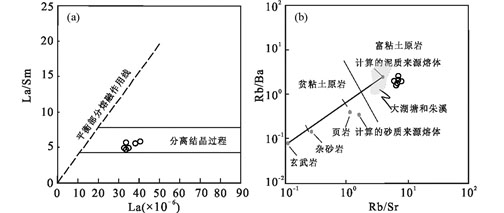
|
图 8 La/Sm-La图解(a,底图据Allègre and Minster, 1978);Rb/Ba-Rb/Sr图解(b,底图据Collins et al., 1982) 大湖塘和朱溪花岗岩数据自Zhao et al. (2021)及其参考文献 Fig. 8 La/Sm vs. La diagram (a, base map after Allègre and Minster, 1978) and Rb/Ba vs. Rb/Sr diagram (b, base map after Collins et al., 1982) Dahutang and Zhuxi data from Zhao et al. (2021) and references therein |
前人针对香炉山钨矿床的年代学研究显示,其形成时代为早白垩世(~127Ma)(陈耿炎, 1990; 张家菁等, 2008; Zhao et al., 2017; Dai et al., 2018; Li et al., 2020)。在白垩纪,香炉山钨矿所在的长江中下游成矿带中的岩浆作用和成矿作用,主要受控于古太平洋板块的俯冲,体现为145~136Ma和136~120Ma两阶段的成矿特征(Sun et al., 2012; Wu et al., 2012; Mao et al., 2013; Zhao et al., 2017, 2021)。对于该时期的成矿动力学背景仍存在争议。Mao et al. (2013)和Zhao et al. (2021)认为古太平洋板片(伊扎纳吉板片)在135Ma前为斜向大陆边缘俯冲,之后平行大陆边缘俯冲。而Zhao et al. (2017)和Ling et al. (2009)认为长江中下游成矿带受控于古太平洋板块的洋脊俯冲,并且在~136Ma后,南侧太平洋板片单侧南东向回撤(Zhao et al., 2017)。长江中下游成矿带成矿规律呈非对称展布(图 1)。在该成矿带北侧的铜金钼铁矿带中,分布有一系列的早白垩世火山岩盆地,以及A型花岗岩(Mao et al., 2013; Xue et al., 2015),指示拉伸环境,及强烈地幔物质的参与。而在成矿带南侧的钨(铜钼)矿带中,包括香炉山花岗岩在内,阳储岭矿床、大湖塘矿床和朱溪矿床的成矿花岗岩均显示出地壳物质部分熔融,及少部分地幔物质加入的特征(Huang and Jiang, 2014; 李岩等, 2014; Mao et al., 2015; 李宏伟等, 2021)。此外,整个华南在136Ma之后形成北东向展布的拉张盆地及向俯冲边界逐渐年轻的火成岩形成特征(Zhou et al., 2006; Li and Li, 2007)。因此,136Ma之后,华南板块下部很可能是伴随着太平洋板片的单向回撤。香炉山花岗岩成分在Rb-(Y+Nb)图解(图 9a)和Nb-Y图解(图 9b)中,投点也均接近于板内花岗岩区域(Pearce et al., 1984),并与全球典型矽卡岩型钨矿成矿花岗岩成分投点接近(Meinert et al., 2005)。值得注意的是,长江中下游成矿带中钨成矿相关花岗岩自早燕山期到晚燕山期投点从火山弧-碰撞型花岗岩区域转变为板内花岗岩区域(图 9),这也伴随着花岗岩氧逸度由高向低的转变(Li et al., 2020),进一步指示了136Ma之后地球动力学背景的转变。综上,香炉山钨矿形成于板内的拉张环境,可能与古太平洋板块中伊扎纳吉板片与太平洋板片间的洋脊俯冲,及太平洋板片回撤有关。
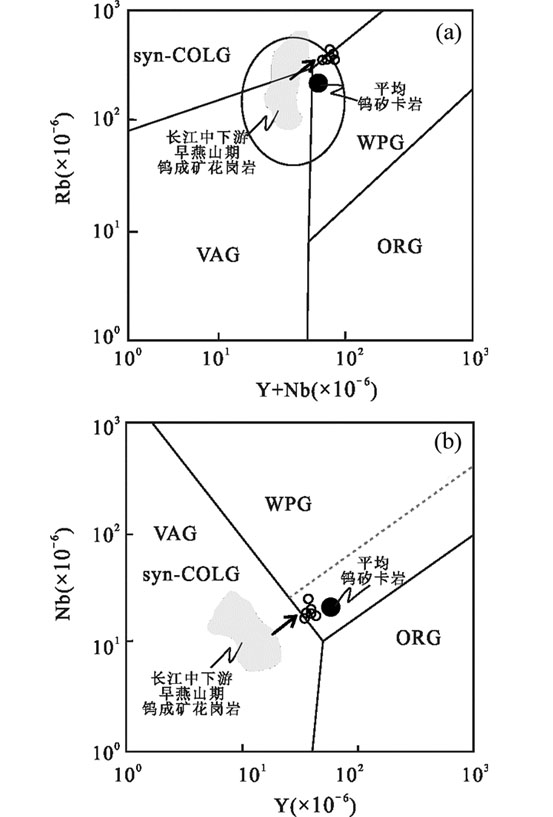
|
图 9 Rb-(Y+Nb)图解(a)和Nb-Y图解(b)(底图据Pearce et al., 1984) 平均矽卡岩钨成矿相关花岗岩数据自Meinert et al. (2005),长江中下游钨成矿花岗岩数据自Zhao et al. (2021)及其参考文献 Fig. 9 Rb vs. (Y+Nb) diagram (a) and Nb vs. Y diagram (b) (base map after Pearce et al., 1984) Geochemical data of average W-skarn related granites from Meinert et al. (2005), geochemical data of W-related granites in the Middle-Lower Yangtze River Metallogenic Belt from Zhao et al. (2021) and references therein |
香炉山钨矿成矿花岗岩为黑云母花岗岩,具有强过铝质特征,属于分异S型花岗岩。香炉山矽卡岩矿物主要为钙铁辉石为主,而石榴石以钙铝榴石为主并有少部分锰铝-铁铝榴石,同时主要的白钨矿分布于矽卡岩晚期网脉中呈贫Mo的特征。因此,香炉山钨矿属于典型的还原型矽卡岩钨矿。还原型的岩浆热液流体和还原型的炭质围岩共同造成了还原型的矽卡岩特征。香炉山花岗岩的物质来源主要为壳源富粘土物质,可能伴有极少量的幔源物质加入。香炉山花岗岩具有板内花岗岩的特征,指示形成于板内的拉张环境,这可能与古太平洋板块中伊扎纳吉板片与太平洋板片间的洋脊俯冲,及太平洋板片回撤有关。
致谢 感谢江西省修水香炉山钨业有限公司为矿区野外工作提供的便利。感谢付晓和黄锦洪在实验测试方面提供的全力协助。感谢周美夫教授、高剑峰研究员、陈伟研究员、赵正研究员和刘泽瑞教授在不同阶段对华南钨锡矿床系列研究的大力支持。同时感谢主编及匿名审稿人对论文提出的宝贵修改意见。
Allègre CJ and Minster JF. 1978. Quantitative models of trace element behavior in magmatic processes. Earth and Planetary Science Letters, 38(1): 1-25 DOI:10.1016/0012-821X(78)90123-1
|
Barth MG, McDonough WF and Rudnick RL. 2000. Tracking the budget of Nb and Ta in the continental crust. Chemical Geology, 165(3-4): 197-213 DOI:10.1016/S0009-2541(99)00173-4
|
Bowman JR. 1998. Stable-isotope systematics of skarns. In: Lentz DR (ed. ). Mineralized Intrusion-Related Skarn Systems. Quebec: Mineralogical Association of Canada, 99-145
|
Chappell BW and White AJR. 1974. Two contrasting granite types. Pacific Geology, 8: 173-174
|
Chen B and Zhou XX. 2012. Ore-controlling factors and a metallogenic model for the Xianglushan tungsten-ore field in northern Jiangxi Province. Geology and Exploration, 48(3): 562-569 (in Chinese with English abstract)
|
Chen GH, Wan HZ, Shu LS, Zhang C and Kang C. 2012. An analysis on ore-controlling conditions and geological features of the Cu-W polymetallic ore deposit in the Zhuxi area of Jingdezhen, Jiangxi Province. Acta Petrologica Sinica, 28(12): 3901-3914 (in Chinese with English abstract)
|
Chen GY. 1990. Geology and genesis of the Xianglushan concealed scheelite deposit. Geology and Prospecting, 1(6): 15-20 (in Chinese with English abstract)
|
Collins WJ, Beams SD, White AJR and Chappell BW. 1982. Nature and origin of A-type granites with particular reference to southeastern Australia. Contributions to Mineralogy and Petrology, 80(2): 189-200 DOI:10.1007/BF00374895
|
Dai P, Mao JW, Wu SH, Xie GQ and Luo XH. 2018. Multiple dating and tectonic setting of the Early Cretaceous Xianglushan W deposit, Jiangxi Province, South China. Ore Geology Reviews, 95: 1161-1178 DOI:10.1016/j.oregeorev.2017.11.017
|
Feng CY, Zhang DQ, Xiang XK, Li DX, Qu HY, Liu JN and Xiao Y. 2012. Re-Os isotopic dating of molybdenite from the Dahutang tungsten deposit in northwestern Jiangxi Province and its geological implication. Acta Petrologica Sinica, 28(12): 3858-3868 (in Chinese with English abstract)
|
Foley SF. 1984. Liquid immiscibility and melt segregation in alkaline lamprophyres from Labrador. Lithos, 17: 127-137 DOI:10.1016/0024-4937(84)90013-6
|
Gilbert SE, Danyushevsky LV, Rodemann T, Shimizu N, Gurenko A, Meffre S, Thomas H, Large RR and Death D. 2014. Optimisation of laser parameters for the analysis of sulphur isotopes in sulphide minerals by laser ablation ICP-MS. Journal of Analytical Atomic Spectrometry, 29(6): 1042-1051 DOI:10.1039/C4JA00011K
|
Huang LC and Jiang SY. 2014. Highly fractionated S-type granites from the giant Dahutang tungsten deposit in Jiangnan Orogen, Southeast China: Geochronology, petrogenesis and their relationship with W-mineralization. Lithos, 202-203: 207-226 DOI:10.1016/j.lithos.2014.05.030
|
Huang XB. 2001. Basic features of decollement structures in the Xiushui-Yongxiu area of Northwest Jiangxi. Jiangxi Geology, 15(2): 81-86 (in Chinese with English abstract)
|
Li HW, Zhao Z, Chen ZY, Guo NX, Gan JW, Li XW and Yin Z. 2021. Genetic relationship between the two-period magmatism and W mineralization in the Dahutang ore-field, Jiangxi Province: Evidence from zircon geochemistry. Acta Petrologica Sinica, 37(5): 1508-1530 (in Chinese with English abstract)
|
Li XY, Zhang JR and Lai CK. 2020. Comparison of magma oxygen fugacity and zircon Hf isotopes between Xianglushan tungsten-nearing granite and Late Yanshanian granites in Jiangxi Province, South China. Minerals, 10(2): 106 DOI:10.3390/min10020106
|
Li Y, Pan XF, Zhao M, Chen GH, Zhang TF, Liu X and Zhang C. 2014. LA-ICP-MS zircon U-Pb age, geochemical features and relations to the W-Cu mineralization of granitic porphyry in Zhuxi skarn deposit, Jingdezhen, Jiangxi. Geological Reviews, 60(3): 693-708 (in Chinese with English abstract)
|
Li ZX and Li XH. 2007. Formation of the 1300-km-wide intracontinental orogen and postorogenic magmatic province in Mesozoic South China: A flat-slab subduction model. Geology, 35(2): 179-182 DOI:10.1130/G23193A.1
|
Ling MX, Wang FY, Ding X, Hu YH, Zhou JB, Zartman RE, Yang XY and Sun WD. 2009. Cretaceous ridge subduction along the Lower Yangtze River belt, eastern China. Economic Geology, 104(2): 303-321 DOI:10.2113/gsecongeo.104.2.303
|
Liu SB, Liu ZQ, Wang CH, Wang DH, Zhao Z and Hu ZH. 2017. Geochemical characteristics of REEs and trace elements and Sm-Nd dating of scheelite from the Zhuxi giant tungsten deposit in Northeast Jiangxi. Earth Science Frontiers, 24(5): 17-30 (in Chinese)
|
Liu Y and Zhou XX. 2010. Tungsten ore resources prediction of Xianglu mountain based on MapGIS integrated with multi-prospecting information. Journal of East China Institute of Technology, 33(3): 262-269 (in Chinese with English abstract)
|
Maniar PD and Piccoli PM. 1989. Tectonic discrimination of granitoids. GSA Bulletin, 101(5): 635-643 DOI:10.1130/0016-7606(1989)101<0635:TDOG>2.3.CO;2
|
Mao JW, Cheng YB, Chen MH and Pirajno F. 2013. Major types and time-space distribution of Mesozoic ore deposits in South China and their geodynamic settings. Mineralium Deposita, 48(3): 267-294 DOI:10.1007/s00126-012-0446-z
|
Mao ZH, Liu JJ, Mao JW, Deng J, Zhang F, Meng XY, Xiong BK, Xiang XK and Luo XH. 2015. Geochronology and geochemistry of granitoids related to the giant Dahutang tungsten deposit, Middle Yangtze River region, China: Implications for petrogenesis, geodynamic setting, and mineralization. Gondwana Research, 28(2): 816-836 DOI:10.1016/j.gr.2014.07.005
|
Meinert LD, Dipple GM and Nicolescu S. 2005. World skarn deposits. In: Hedenquist JW, Thompson JFH, Goldfarb RJ and Richards JR (eds. ). One Hundredth Anniversary Volume. Society of Economic Geologists, 299-336
|
Middlemost EAK. 1994. Naming materials in the magma/igneous rock systems. Earth-Science Reviews, 37(3-4): 215-224 DOI:10.1016/0012-8252(94)90029-9
|
Müller W, Shelley M, Miller P and Broude S. 2009. Initial performance metrics of a new custom-designed ArF excimer LA-ICPMS system coupled to a two-volume laser-ablation cell. Journal of Analytical Atomic Spectrometry, 24(2): 209-214 DOI:10.1039/B805995K
|
Newberry RJ and Einaudi MT. 1981. Tectonic and geochemical setting of tungsten skarn mineralization in the Cordillera. Arizona Geological Society Digest, 14: 99-111
|
Newberry RJ and Layer PW. 1998. The pine creek W-Mo-Cu-Bi-Au skarn, California: Multiple skarns associated with a thermal, chemical, and isotopic anomaly in the central Sierra Nevade. Geological Association of Canada Program with Abstracts, 23: 135
|
Pearce JA, Harris NBW and Tindle AG. 1984. Trace element discrimination diagrams for the tectonic interpretation of granitic rocks. Journal of Petrology, 25(4): 956-983 DOI:10.1093/petrology/25.4.956
|
Romer RL and Kroner U. 2016. Phanerozoic tin and tungsten mineralization-tectonic controls on the distribution of enriched protoliths and heat sources for crustal melting. Gondwana Research, 31: 60-95 DOI:10.1016/j.gr.2015.11.002
|
Sun SS and McDonough WF. 1989. Chemical and isotopic systematics of oceanic Basalts: Implications for mantle composition and processes. In: Saunders AD and Norry MJ (eds. ). Magmatism in the Ocean Basins. Geological Society, London, Special Publications, 42(1): 313-345
|
Sun WD, Yang XY, Fan WM and Wu FY. 2012. Mesozoic large scale magmatism and mineralization in South China: Preface. Lithos, 150: 1-5 DOI:10.1016/j.lithos.2012.06.028
|
Sylvester PJ. 1998. Post-collisional strongly peraluminous granites. Lithos, 45(1-4): 29-44 DOI:10.1016/S0024-4937(98)00024-3
|
Tian BS and Yuan BY. 2008. Geological characteristics and prospecting criteria of Xianglushan tungsten deposit, northwestern Jiangxi Province. Geological Journal of China Universities, 14(1): 114-119 (in Chinese with English abstract)
|
Wang DH, Tang JX, Ying LJ, Chen ZH, Xu JX, Zhang JJ, Li SR and Zeng ZL. 2010. Application of "Five levels+basement" model for prospecting deposits into depth. Journal of Jilin University (Earth Science Edition), 40(4): 733-738 (in Chinese with English abstract)
|
Wedepohl KH. 1995. The composition of the continental crust. Geochimica et Cosmochimica Acta, 59(7): 1217-1232 DOI:10.1016/0016-7037(95)00038-2
|
Whalen JB, Currie KL and Chappell BW. 1987. A-type granites: Geochemical characteristics, discrimination and petrogenesis. Contributions to Mineralogy and Petrology, 95(4): 407-419 DOI:10.1007/BF00402202
|
Wong KH, Zhou MF, Chen WT, O'Brien H, Lahaye Y and Chan SLJ. 2017. Constraints of fluid inclusions and in-situ S-Pb isotopic compositions on the origin of the North Kostobe sediment-hosted gold deposit, eastern Kazakhstan. Ore Geology Reviews, 81: 256-269 DOI:10.1016/j.oregeorev.2016.10.004
|
Wu FY, Ji WQ, Sun DH, Yang YH and Li XH. 2012. Zircon U-Pb geochronology and Hf isotopic compositions of the Mesozoic granites in southern Anhui Province, China. Lithos, 150: 6-25 DOI:10.1016/j.lithos.2012.03.020
|
Wu SH, Wang XD and Xiong BK. 2014. Fluid inclusion studies of the Xianglushan skarn tungsten deposit, Jiangxi Province, China. Acta Petrologica Sinica, 30(1): 178-188 (in Chinese with English abstract)
|
Wu SH, Mao JW, Ireland TR, Zhao Z, Yao FJ, Yang YP and Sun WD. 2019. Comparative geochemical study of scheelite from the Shizhuyuan and Xianglushan tungsten skarn deposits, South China: Implications for scheelite mineralization. Ore Geology Reviews, 109: 448-464 DOI:10.1016/j.oregeorev.2019.04.021
|
Wu SH, Sun DY and Li J. 2020. Comparison of trace elements in sulfides from the Shizhuyuan and Xianglushan W polymetallic deposits: Constrained by LA-ICP-MS analysis. Acta Petrologica Sinica, 36(1): 245-256 (in Chinese with English abstract) DOI:10.18654/1000-0569/2020.01.20
|
Xiang XK, Liu XM and Zhan GN. 2012. Discovery of Shimensi super-large tungsten deposit and its prospecting significance in Dahutang area, Jiangxi Province. Resources Survey & Environment, 33(3): 141-151 (in Chinese with English abstract)
|
Xie GQ, Mao JW, Li XW, Duan C and Yao L. 2011. Late Mesozoic bimodal volcanic rocks in the Jinniu basin, Middle-Lower Yangtze River Belt (YRB), East China: Age, petrogenesis and tectonic implications. Lithos, 127(1-2): 144-164 DOI:10.1016/j.lithos.2011.08.012
|
Xue HM, Ma F and Cao GY. 2015. Geochronology and petrogenesis of shoshonitic igneous rocks, Luzong volcanic basin, Middle and Lower Yangtze River Reaches, China. Journal of Asian Earth Sciences, 110: 123-140 DOI:10.1016/j.jseaes.2015.03.020
|
Yin Z, Zhao Z, Tao JL, Wu SH, Li HW, Gan JW, Chen W and Li XW. 2021. Deposit geology, geochronology and metallogenic model of Helong W deposit in southern Jiangxi Province. Acta Petrologica Sinica, 37(5): 1531-1552 (in Chinese with English abstract)
|
Yuan Y, Liao ZT and Wang C. 2012. Multi-stage tectonic evolution in Jiangnan uplift (Jiuling terran) from granitoids records. Journal of Tongji University (Natural Science), 40(9): 1414-1421 (in Chinese with English abstract)
|
Zhang JJ, Mei YP, Wang DH and Li HQ. 2008. Isochronology study on the Xianglushan scheelite deposit in north Jiangxi Province and its geological significance. Acta Geologica Sinica, 82(7): 927-931 (in Chinese with English abstract)
|
Zhang ZJ, Zhang XH and Yi SH. 2003. Intraplate tectonic deformation of the Precambrian in the Mufu and Jiuling mountains area, North-West Jiangxi. Geological Journal of China Universities, 9(1): 81-88 (in Chinese with English abstract)
|
Zhao WW, Zhou MF, Li YHM, Zhao Z and Gao JF. 2017. Genetic types, mineralization styles, and geodynamic settings of Mesozoic tungsten deposits in South China. Journal of Asian Earth Sciences, 137: 109-140 DOI:10.1016/j.jseaes.2016.12.047
|
Zhao WW, Zhou MF, Williams-Jones AE and Zhao Z. 2018a. Constraints on the uptake of REE by scheelite in the Baoshan tungsten skarn deposit, South China. Chemical Geology, 477: 123-136 DOI:10.1016/j.chemgeo.2017.12.020
|
Zhao Z, Chen YC, Zeng ZL, Guo NX, Chen ZH, Wang DH, Liu CH, Liu ZY, Wang PA and Li JD. 2017a. Jiangxi Yinkeng W-Ag-Au ore field's metallogenic regularity and prospecting direction: As well as the superposition of two metallogenic series in southern China. Earth Science Frontiers, 24(5): 54-61 (in Chinese with English abstract)
|
Zhao Z, Wang DH, Chen YC, Liu SB, Fang GC, Liang T, Guo NX, Wang SY, Wang HY, Liu ZQ, Zeng ZL, Ding M, Chen W and Zhou XP. 2017b. "Jiulongnao metallogenic model" and the demonstration of deep prospecting: The extended application of "Five levels + Basement" exploration model. Earth Science Frontiers, 24(5): 8-16 (in Chinese with English abstract)
|
Zhao Z, Zhou XP, Guo NX, Zhang HY, Liu ZY, Zheng YL, Zeng ZL and Chen YC. 2018b. Superimposed W and Ag-Pb-Zn(-Cu-Au) mineralization and deep prospecting: Insight from a geophysical investigation of the Yinkeng orefield, South China. Ore Geology Reviews, 93: 404-412 DOI:10.1016/j.oregeorev.2018.01.017
|
Zhao Z, Fu TY, Gan JW, Liu C, Wang DH, Sheng JF, Li WB, Wang PA, Yu ZF and Chen YC. 2021. A synthesis of mineralization style and regional distribution and a proposed new metallogenic model of Mesozoic W-dominated polymentallic deposits in South China. Ore Geology Reviews, 133: 104008 DOI:10.1016/j.oregeorev.2021.104008
|
Zhong YF, Ma CQ, She ZB, Lin GC, Xu HJ, Wang RJ, Yang KG and Liu Q. 2005. SHRIMP U-Pb zircon geochronology of the Jiuling granitic complex batholith in Jiangxi Province. Earth Science (Journal of China University of Geosciences), 30(6): 685-691 (in Chinese with English abstract)
|
Zhou XM, Sun T, Shen WZ, Shu LS and Niu YL. 2006. Petrogenesis of Mesozoic granitoids and volcanic rocks in South China: A response to tectonic evolution. Episodes, 29(1): 26-33 DOI:10.18814/epiiugs/2006/v29i1/004
|
陈波, 周贤旭. 2012. 赣北香炉山钨矿田矿床控制因素及成矿模式. 地质与勘探, 48(3): 562-569. |
陈耿炎. 1990. 香炉山隐伏白钨矿矿床地质特征及成因探讨. 地质与勘探, 1(6): 15-20. |
陈国华, 万浩章, 舒良树, 张诚, 康川. 2012. 江西景德镇朱溪铜钨多金属矿床地质特征与控矿条件分析. 岩石学报, 28(12): 3901-3914. |
丰成友, 张德全, 项新葵, 李大新, 瞿泓滢, 刘建楠, 肖晔. 2012. 赣西北大湖塘钨矿床辉钼矿Re-Os同位素定年及其意义. 岩石学报, 28(12): 3858-3868. |
黄修保. 2001. 赣西北修水-永修地区滑脱构造的基本特征. 江西地质, 15(2): 81-86. |
李宏伟, 赵正, 陈振宇, 郭娜欣, 甘加伟, 李小伟, 尹政. 2021. 江西大湖塘矿田两期岩浆作用与钨成矿的关系: 来自锆石矿物地球化学的证据. 岩石学报, 37(5): 1508-1530. |
李岩, 潘小菲, 赵苗, 陈国华, 张天福, 刘茜, 张诚. 2014. 景德镇朱溪钨(铜)矿床花岗斑岩的锆石U-Pb年龄、地球化学特征及其与成矿关系探讨. 地质论评, 60(3): 693-708. |
刘善宝, 刘战庆, 王成辉, 王登红, 赵正, 胡正华. 2017. 赣东北朱溪超大型钨矿床中白钨矿的稀土、微量元素地球化学特征及其Sm-Nd定年. 地学前缘, 24(5): 17-30. |
刘勇, 周贤旭. 2010. 基于MapGIS综合找矿信息香炉山钨矿田钨矿资源预测. 东华理工大学学报(自然科学版), 33(3): 262-269. DOI:10.3969/j.issn.1674-3504.2010.03.08 |
田邦生, 袁步云. 2008. 赣西北香炉山钨矿床地质特征与找矿标志. 高校地质学报, 14(1): 114-119. DOI:10.3969/j.issn.1006-7493.2008.01.013 |
王登红, 唐菊兴, 应立娟, 陈郑辉, 许建祥, 张家菁, 李水如, 曾载淋. 2010. "五层楼+地下室"找矿模型的适用性及其对深部找矿的意义. 吉林大学学报(地球科学版), 40(4): 733-738. |
吴胜华, 王旭东, 熊必康. 2014. 江西香炉山矽卡岩型钨矿床流体包裹体研究. 岩石学报, 30(1): 178-188. |
吴胜华, 孙冬阳, 李军. 2020. 柿竹园和香炉山W多金属矿床中硫化物微量元素特征: 来自原位LA-ICP-MS分析. 岩石学报, 36(1): 245-256. |
项新葵, 刘显沐, 詹国年. 2012. 江西省大湖塘石门寺矿区超大型钨矿的发现及找矿意义. 资源调查与环境, 33(3): 141-151. DOI:10.3969/j.issn.1671-4814.2012.03.002 |
尹政, 赵正, 陶建利, 吴胜华, 李宏伟, 甘加伟, 陈伟, 李小伟. 2021. 赣南合龙钨矿矿床地质、成岩成矿时代与成矿模式. 岩石学报, 37(5): 1531-1552. |
袁媛, 廖宗廷, 王超. 2012. 江南隆起(九岭)多阶段构造演化的花岗岩记录. 同济大学学报(自然科学版), 40(9): 1414-1421. DOI:10.3969/j.issn.0253-374x.2012.09.023 |
张家菁, 梅玉萍, 王登红, 李华芹. 2008. 赣北香炉山白钨矿床的同位素年代学研究及其地质意义. 地质学报, 82(7): 927-931. DOI:10.3321/j.issn:0001-5717.2008.07.010 |
章泽军, 张雄华, 易顺华. 2003. 赣西北幕阜山-九岭山一带前震旦纪构造变形. 高校地质学报, 9(1): 81-88. DOI:10.3969/j.issn.1006-7493.2003.01.010 |
赵正, 陈毓川, 曾载淋, 郭娜欣, 陈郑辉, 王登红, 刘翠辉, 刘宗翊, 王平安, 李江东. 2017a. 江西银坑W-Ag-Au多金属矿田成矿规律与找矿方向: 兼论华南两个成矿系列叠加问题. 地学前缘, 24(5): 54-61. |
赵正, 王登红, 陈毓川, 刘善宝, 方贵聪, 梁婷, 郭娜欣, 王少轶, 王浩洋, 刘战庆, 曾载淋, 丁明, 陈伟, 周新鹏. 2017b. "九龙脑成矿模式"及其深部找矿示范: "五层楼+ 地下室"勘查模型的拓展. 地学前缘, 24(5): 8-16. |
钟玉芳, 马昌前, 佘振兵, 林广春, 续海金, 王人镜, 杨坤光, 刘强. 2005. 江西九岭花岗岩类复式岩基锆石SHRIMP U-Pb年代学. 地球科学(中国地质大学学报), 30(6): 685-691. |
 2022, Vol. 38
2022, Vol. 38

